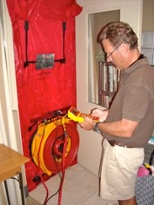What Is Pressure? – Understanding Air Leakage

Put your hand out, palm up. Believe it or not, you’re now holding about 200 pounds of air in your hand. You may have heard that standard atmospheric pressure is 14.7 pounds per square inch. Your hand is probably in the range of 15 square inches. Thus, the amount of pressure pushing down on your hand is about 200 pounds.
Well, then, you may wonder, “Why doesn’t it feel like I’m holding 200 pounds?” The secret is that air – a fluid – is a sneaky substance. In this case, it sneaks around to the other side of your hand and pushes up with that same force of about 200 pounds.
Two hundred pounds pushing down. Two hundred pounds pushing up. It feels like nothing because that’s the net result.
In this example, the pressure, which is a force per unit area, is the result of gravity. It’s the weight of all the air above your hand. Even though it’s due to gravity, though, the pressure in a fluid presses in all directions, not just downward. Hence the air pushing up on the back side of your hand.
OK, let’s apply this to buildings now because I’m not a physics professor anymore. I teach building science, and that’s most likely why you’re here. Your hand is now the wall of a house. Visualize it changing the way those “tickets to that thing you love” turned into precious gems: “The tickets are now diamonds!” (Sorry. I love that Old Spice ad.)
The air inside the house pushes outward on the wall, while the air outside pushes inward. If the air inside is connected directly to the air outside – from an open door or window, say – the pressure should be the same in each direction, as with your hand in the example above, and nothing happens. If, however, the house is closed up, we may have a pressure difference between inside and outside.
Will this pressure difference result in air leakage? The practical answer is yes, because the house as tight as a vacuum chamber has not been built yet.
What this points out to us that there are two requirements for air leakage. There has to be both:
- Pressure difference
- Pathway
If the house is closed up, and something creates a pressure difference between inside and out, the surfaces of the building envelope have air pressing harder from one direction than the other. If, going back to our earlier example, the air below your hand suddenly disappeared, leaving vacuum in its wake, you’d feel those 200 pounds pressing down on your hand.
Likewise, a pressure difference across a house forces air to move through the holes in the building envelope, from the side with higher air pressure to the side with lower pressure. The bigger that pressure difference, the more air that will move through the holes. The more the area of the holes, the more that air will move across the building envelope.
When pressure differences appear, that sneaky substance, air, will do its best to find and move through the holes.
There’s one case when we do  this intentionally – during a Blower Door test. The energy auditor turns up the Blower Door fan to create a given pressure difference (usually 50 Pascals) and then measures the amount of air moving through the fan. The more air flow, the more leaks in the envelope.
this intentionally – during a Blower Door test. The energy auditor turns up the Blower Door fan to create a given pressure difference (usually 50 Pascals) and then measures the amount of air moving through the fan. The more air flow, the more leaks in the envelope.
Pressure difference. Pathways. Understand this simple principle of physics, and you can go far in the world of building science.
I’m on a horse.
Allison A. Bailes III, PhD is a speaker, writer, building science consultant, and the founder of Energy Vanguard in Decatur, Georgia. He has a doctorate in physics and writes the Energy Vanguard Blog. He also has a book on building science coming out in the summer of 2022. You can follow him on Twitter at @EnergyVanguard.
Related Articles
Rats to You, Daniel Bernoulli! – Understanding Air Pressure (with a cool video!)
Infiltration Occurs at the Surface, Not in the Volume
It’s the Hole – Understanding What a Blower Door Is for
Photo hot air balloons by Mike Willis from flickr.com, used under a Creative Commons license.
This Post Has 3 Comments
Comments are closed.

I have a complicated question
I have a complicated question about pressure. As my team and I seal up a house and perform blower door tests as we go to check our progress, it seems to us that it gets harder and harder to reduce that cfm50 number. We speculate that as we seal up envelope leaks, the remaining leaks leak harder, so that we get reduced returns on the leaks we seal as we seal more leaks.
Jeff, as long as you’re
Jeff, as long as you’re testing with a 50 Pascal pressure difference every time, I don’t think that ‘the remaining leaks leak harder.’ The only way that would happen is if the house were so leaky at first that you couldn’t get to 50 Pa, and as you continued testing, you increased the pressure difference until you got to 50 Pa. I think it’s probably just a matter of having sealed up the big, easy to seal leaks, so the remaining area is smaller.
Another home performance contractor once told me, though, that sometimes you could have a ‘mad air’ thing going on, where you seal up some leaks and make the air angry so it finds new leaks. Fluid dynamics is pretty complex, and there could be some of that going on, but I think it’s mainly just the diminishing returns of having sealed up the big stuff already.
I love, love, love that ad.
I love, love, love that ad.
I love, love, love your writing.